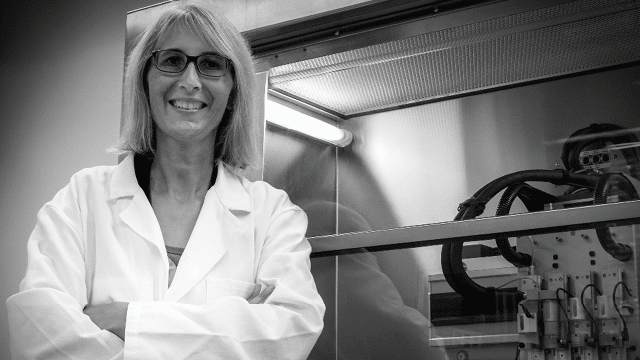Can you tell us about yourself, your role at your current company/institution and what you do there?
My name is Barbara Rothen-Rutishauser. I’m a professor of BioNanomaterials in the Adolphe Merkle Institute at the University of Fribourg, Switzerland. I co-chair the BioNanomaterials group with my colleague Prof. Alke Fink. She is a materials engineer by training, and I’m a cell biologist, so we are very complementary. This is reflected in the different projects we are currently undertaking which can be material focused or centered around biological tissue models. My work is mostly research-related. I supervise projects, write grants and papers, and work alongside our partners. In addition, I also do some administrative work and teach classes at university.
How did you get started with 3D bioprinting?
It was about eight years ago when Marc Thurner, the former founder and CEO of REGENHU, approached us for a collaboration through which we were able to obtain funds to acquire a 3D bioprinter and start our first research project aimed at designing an in vitro lung model based on a novel bioprinting approach.
What motivates you most about your work?
The freedom of being able to define the directions of our research, and build on our expertise and our networks. If I come up with an idea, I’m free to make it a reality and that, to me, is really what I love the most about my work. Another important driver for me is to find ways to reduce and eliminate animal testing. One approach is to improve tissue models that also allow testing of novel nanoparticles or drugs. Finding ways to help improve lives while reducing animal experimentation is very rewarding to me.
What projects are you currently working on?
We have quite a broad spectrum of interesting projects. We currently have a number where we investigate nanoparticle design in order to find out how these particles can direct cell behavior. We also have some applied projects where we use advanced tissue models. An important part of my research revolves around lung models – improving their reliability and robustness – and testing nanoparticles that can be released in an occupational scenario. We recently implemented other tissue models such as skin and intestine tissue. It’s mainly about hazard assessment and testing novel drugs.
How are 3D bioprinting/bioprinting technologies involved in your work?
We are currently part of a SINERGIA consortium, a project funded by the Swiss National Science Foundation. It’s a collaboration between the University of Applied Swiss Sciences, the University of Basel, and the University Hospital of Basel. For this project, we have been tasked with creating a model of the human omentum, a tissue sheet in the stomach that seems to play an important role in the development of ovarian cancer. One of my PhD students is using a 3D bioprinter to design a 3D model of the omentum including endothelial cells, mesothelial cells, fat cells, microphage spheroids, etc. We want to have a model where we can test personalized cells with different chemotherapy drugs.
What are some of the challenges that you see in the field of bioprinting and day-to-day in your lab?
Bioprinters currently rely on a lot of expertise in order to function both from a technical and biological perspective. I think whoever uses the bioprinters needs to have some technical experience, or have a biological background and be motivated to learn. Using the machines for cell cultures can also be quite difficult, but this can be easily fixed by organizing trainings and workshops.
Would you say there is gender inequality in the sector? What would companies like us need to do to bridge the gap?
Personally, I know a few female principal investigators (PIs) working in bioprinting so I cannot comment on that. However, I have observed that women tend to be less confident than men in their research. They need to make sure that everything is correct before taking a decision while men, on the other hand, aren’t afraid to take risks. This is because, as women, we are less exposed to engineering. In order to solve these issues, companies should put women and their work front and center more often, organize more training and workshops, and show them that it’s acceptable to try new ideas.
It would be wonderful to see younger generations embrace science and engineering as a career option, how do you think we can encourage more involvement from girls and young women in these sectors?
I believe that exposure is crucial in this regard. We need to raise awareness of STEM and bioprinting as a career path for women and young girls everywhere. That can be achieved by organizing workshops, open-door days, going to schools, etc. For example, we go to schools and show kids different technologies. We also hold open-door days where we showcase our bioprinter to the public. Putting women working in STEM in the spotlight is also another good way to do this. That way, girls can have role models to look up to, and believe that they too can one day become amazing researchers and leaders in STEM.
What advice would you give young women who want to develop their career in this rapidly-evolving sector?
Be confident and don’t be afraid to get out of your comfort zone. I also recommend you find a research niche. Although this can be risky, it will help boost your career in the future as you continue to specialize.

